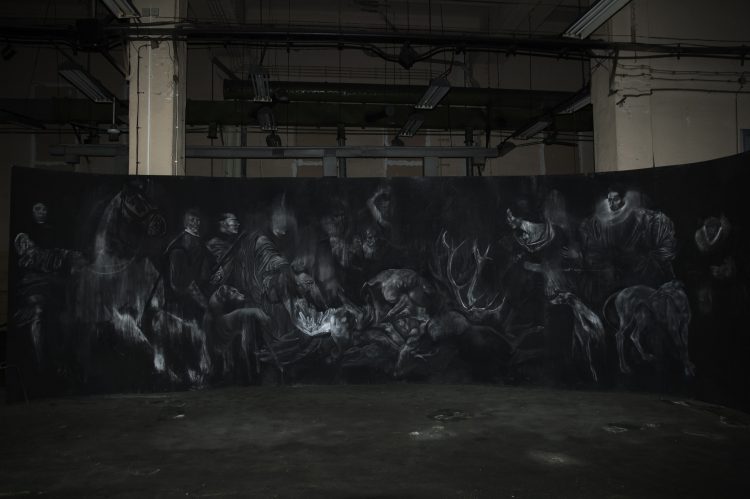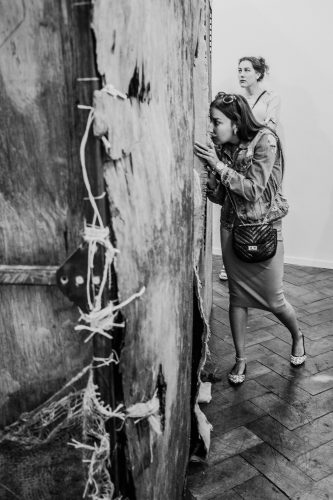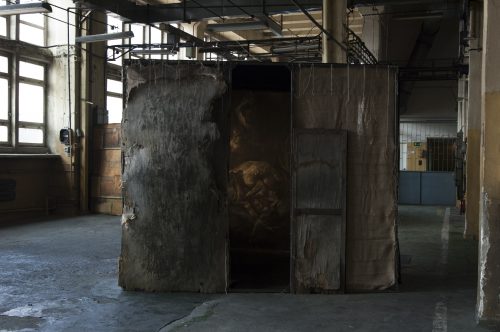The Word for World Is Forest

Krzysztof Gil: Tajsa Yesterday and Tomorrow, installation presented at the exhibition, Welcome to the Country Where the Gypsy Has Been Hunted, Henryk Gallery, Cracow, curator: Wojciech Szymański. Photos: Krzysztof Gil.
I had planned to discuss here the art of emancipation, an original perspective, and the starting point taken by an artist who brings a breath of fresh air. Drawing on the works of Krzysztof Gil, I had intended to analyse his visual strategies, which decolonise canonical art in an original and personal way, exploring elements neglected by the majority history that looms large. Their visual perspective fills in blank spots and unpainted spaces, but also appropriates classical paintings to give them new character and meaning. Perhaps this text will still cover that, but the conditions of possibility – in Marxist terms – have changed a lot here in Poland, and I cannot ignore that. In her final book, Regarding the Pain of Others, Susan Sontag wrote that in each instance, images of horror challenge us to become spectators: we may either be cowards, unable to face them, diverting our gaze, or we may work up that courage to look attentively and bear witness.
The Hunt
The real images from recent months have drawn me back to Krysztof Gil’s 2018 PhD thesis, TAJSA Yesterday and Tomorrow, presented within Gil’s solo exhibition, Welcome to the Country Where the Gypsy Has Been Hunted, curated by Wojciech Szymański, at Galeria Henryk in Cracow. The artist’s point of departure for his work was an excerpt from a seventeenth-century German hunting chronicle, which lists the specimens hunted: “one beautiful stag was slain, five does, three sizeable wild boars, nine smaller boars, two male gypsies, one female and one baby gypsy”.[1] In 17th-century Germany and the Netherlands, killing a Roma was legally permitted without repercussions. In fact, it was even customary to hunt down Roma. The title of the installation – TAJSA Yesterday and Tomorrow refers to temporal space: for Gil, this word Tajsa, taken out of context, has become a metaphor for time, in which he sees a critical review of not only the past, but also the present.
The installation features a large-scale, 2.5 x 10 metre painting, depicting the moment when hunters bring together and display all the prey of the hunt. According to the exhibition curator, the figures portrayed by Krzysztof Gil resemble the rich Amsterdammers from Rembrandt’s 1632 painting, The Anatomy Lesson of Dr Tulp. The painting presents the corpse of a deer, a hare, a bird and a human body. There are dogs guarding their masters’ prey. The cross-section of the bodies lying on top of each other refers to Dutch still life painting. Beautiful in its aesthetic form, the painting emphasises the cruelty of the situation and its deep perversion.
The artist placed this huge panorama in a makeshift ‘house’ modelled on nomadic tents. He concealed it, somewhat limiting its exposure, and thereby rescaling perception – from a great artwork with figures referring to the canon of classical painting, to the sphere of an invisible, hidden story. Gil’s painting plays with non-visibility, both in its formal structure conveying real darkness and in its symbolic emphasis that the viewer/observer may easily recognise only the elements they are familiar with, like the figures from Rembrandt’s paintings. In her text, Przeszła przyszłość znaczy tajsa [The Past Future Means Tajsa], Monika Weychert writes: “What remains almost invisible, however, is the centrally placed compositional dominant: the body of Heidenjiehten’s victim, a dead human being whose limbs are intertwined with the bodies of the animals brought together on display. The public can barely notice it, because they lack the interpretative tools to do so. They only see what is given to them through the educational process: elements of the dominant culture, instead of what has been shown to them – Heidenjachten”.[2]
The second element of the installation is voice. Upon entering this makeshift hut, the audience must struggle to see the whole panorama: they have to strain their eyes, adjust to the darkness, and estimate distances, and the size and dynamics of the figures. This process is accompanied by a story about a contemporary crime, the story of the artist’s grandmother, who reminisces about the murder of her Romani father and the fact that no one was punished for it.
The entire installation appears as an emanation of affective memory – one based on the collective processing of the trauma of personal histories. Here, the affective diversity penetrates the corners of existence and undermines the model of a monolithic majority community, whose reading of classical history is cracking at the seams, allowing the emergence of communities that are ‘separated’, yet by no means passive, and actually possess ethical and political causative power.
And here, we arrive to the present day, because in some symbolic way I had a dream about Gil’s installation at a time when the situation on the Polish-Belarusian border has taken the form of structural and regular violence. When I told him about my observations, Krzysztof himself admitted that ever since the situation on the border had arisen, he had been returning to the subject of hunting.

Krzysztof Gil: Tajsa Yesterday and Tomorrow, installation presented at the exhibition, Welcome to the Country Where the Gypsy Has Been Hunted, Henryk Gallery, Cracow, curator: Wojciech Szymański. Photos: Krzysztof Gil
The Border
At the time of this writing, hundreds of people are stranded on the Polish-Belarusian border since August, provoked by the Lukashenko regime to travel to Europe. In an attempt to oppose the sanctions imposed by the European Union after the fraudulent presidential elections, the Lukashenko regime allowed visa-free flights from the countries of the Middle East and launched the human trafficking machine, drawing huge financial profits from it. Migrants arrive in Minsk and, from that moment on, are held hostage by the situation. They are sent to the border by bus, robbed and beaten, and forced to cross the green border with Poland, threatened with death by Belarusian soldiers. In September, the Polish parliament declared a state of emergency, which means that no one but the border guards are allowed to access the border strip with Belarus. Medics, NGOs helping migrants, and the media cannot enter; all this so that the Polish Border Guard can push migrants from countries such as Afghanistan, Kurdistan, Iraq, Iran, and Syria back into the forest on the Belarusian side, keeping them from seeking international protection on the basis of the Geneva Convention and the Charter of Fundamental Rights.
The migrants are hiding in the forests of the Podlasie region to avoid being pushed back to the Belarusian side again, with no perspective on what to do next. Many of them have experienced pushback many times, and their condition continues to deteriorate. The migrants remaining in the forest, exposed to already harsh winter weather, are very often soaking wet, short of water and food, freezing and on the verge of exhaustion. In the border zone, they are likely to encounter animals, local villagers or border guards who will push them back to the Belarusian side. The area under the state of emergency, which covers the length of the border with Belarus, is called the ‘death strip’ by migrants and those who help them. The migrants are supported by local residents, the Granica Group and numerous other organisations, collectives and individuals from across Poland, but their activities are carried out with no support from the state, in fact – in conspiracy, against the state.
No one knows how many people have died on that land, in those forests. No one can tell how many people are hiding there or what their state is. They are all at risk of hypothermia and death. Witnesses report corpses lying in the forest. And the Border Guard’s hunt continues. As Susan Sontag might say, they are searching for them, so that they do not really see them. The authorities have deprived us of the possibility to look, lest we become witnesses. But these images cannot go unnoticed, if you are willing to be an observer. The images that have begun to accompany us are images of violence, sadness, and death, albeit referred to as ‘defending Polish borders’ and ‘security’ by the state narrative – in the public debate, violence is normalised as a strategy of ‘care’. This is the classic image of social norms which teach us that there are people recognised as Poles, and there are those who belong in the darkness of memory, who have come from a ‘foreign’ place.
The question of the definition of humanity, which seemed to be a historical question only a short while ago, is now making its way back into the public debate. The question of who is human in legal terms, but also in terms of compassion, empathy and recognition of their right to receive assistance rather than to be persecuted and prosecuted. The boundary of humanity has been forcibly drawn on a geopolitical map, and the forest is where all this drama is taking place. One of the migrants – a Syrian journalist – said that in the forest he had become ‘a game’[3], a hunted animal. During the day he rested with his group, so that at night, under cover of darkness, they could move to a place where they would not be pushed back into the Belarusian forests.
A few days ago, the website of the Narewka commune, which remains under the state of emergency, published a notice about the designation of hunting grounds in the forests where the migrants are hiding from the abuse of the Polish authorities. On 5 December, the Puszcza Hunting Club from Białowieża organised a hunt in the areas where the migrants were likely to have tried to cross the border the day before.
The tangible reality of the chase, flight, power loss, struggle for survival, and fear, monstrous fear, is not an image that the antagonists of the helpers see. This is also true of Krzysztof Gil’s painting – gloomy, where many details get lost when seen from a distance, although it leaves no doubt that it is dark there. One has to come closer, in a sense, step into the situation, squint their eyes and notice the nuances. Notice the human body.

Krzysztof Gil: Tajsa Yesterday and Tomorrow, installation presented at the exhibition, Welcome to the Country Where the Gypsy Has Been Hunted, Henryk Gallery, Cracow, curator: Wojciech Szymański. Photos: Krzysztof Gil
Cafe Polonia
Since the crisis on the Polish-Belarusian border began, I have been thinking about the project that Katarzyna Roj, Krzysztof Gil and I had planned for 2017. It was a painting project – a mural depicting Polish refugees in Iran on the wall of a gallery in Isfahan. We collaborated with Iranian curator Amin Fakhari on an exhibition about Cafe Polonia, an establishment in Isfahan and the first European-style café, frequented by Isfahan’s Iranian elite. In a sense, the café opened thanks to Polish refugees: they provided a pretext for an Armenian couple to set up a place to drink coffee and sit at tables. In 1942, Iran received 116,000 Polish refugees who fled Siberia with General Anders’ Army. In 2017, our project was not realised; yet, the exhibition did take place with the participation of several other people.
Katarzyna Roj and I approached the subject during our stay in Isfahan in 2015. It turned out that Polish refugees provide an important local historical context and that there is a need to explore the micro-history of those times, of individual people, and of remembered images. We thought that reworking this situation, researching the stories of Polish migrants, had an incredible potential.
In 2017, I managed to interview witnesses from the time when Polish refugees first made their way into Isfahan; they told me that many of them were in a terrible state, sick, hungry, exhausted. Poles were welcomed and allowed to stay in a safe place. Many of them had certainly faced traumatic events, the loss of loved ones, abuse by Soviet troops and guards, but at that point they were able to have a moment’s respite. No one was chasing them, no one was trying to push them back.
Art as an inclusive space offers an opportunity to address issues that escape collective memory for the benefit of the imagined well-being of the majority. Iran is distant from Poland today, both mentally and psycho-geographically, but I feel tempted to draw these perspectives closer together – to present the canonical heroes of General Anders’ army in the broader picture of Iranian hospitality. It is impossible to process what we hide from each other these days without new approaches and interpretations. Krzysztof Gil’s paintings are emanations of this experience. We intend to return to the subject of Cafe Polonia and speak about the tangible, material need to open up to the real presence in an affective way. And to somehow disenchant today’s image of the forest that is the world.
Joanna Synowiec
[1]This chronicle has been quoted by, among others, Andrzej Mirga and Lech Mróz in their book, Cyganie, odmienność i nietolerancja [Gypsies, Dissimilarity and Intolerance], Wydawnictwo Naukowe PWN, 1994.
[2]Gil, Krzysztof, and Monika Weychert: Tajsa. Wczoraj i jutro / Przeszła przyszłość znaczy „tajsa” [Tajsa: Yesterday and Tomorrow / Past Future Means “Tajsa”], see: https://wuwr.pl/pkult/article/view/12037
[3]https://oko.press/moja-zbrodnia-to-moj-paszport-reporter-oko-press-na-szlaku-uchodzcow/

[…] Previous Blog Entry […]